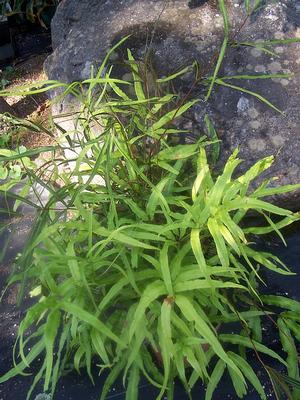Printed at http://www.quackingrassnursery.com/index.cfm/
Pteris cretica 'Eco Hardy Giant'
Cretan Brake Fern
Plant Type:
FERNSPteris cretica 'Eco Hardy Giant' – This very rare selection of Cretan Brake Fern (*one common moniker of several...) by the late Don Jacobs of Eco Gardens in Decatur, Georgia, apparently has somewhat greater hardiness though we have found no pertinent information regarding this selection. Also known as Table Fern (*another common moniker) because it makes a great house plant as well as garden candidate where it can be grown outdoors this selection appears to grow into a much larger evergreen specimen than the few others we have seen offered. Narrow leaflets give rise to yet another common name, Ribbon Fern (*yet another). Because it has spored about here and there in temperate forests warmer than ours some are uncertain as to its actual nativity though others report it as being from southern Japan and on Kyushu where it is beautiful in the rocky, damp forest setting. According to http://botanyboy.org, “In Florida I remember seeing Pteris cretica growing in old lime rock quarries. Apparently it is also common in Mexico and Guatemala, but more rare, yet widespread, in the rest of Latin America.” Most list Pteris cretica, or Wimsettii Cretan Brake (*another namesake! Are you kidding???), with USDA zone 7 to 11 hardiness. As Don Jacobs listed owali (*again?? Oh no you di'nt) as having greater genetic hardiness we're going to make a stab at 6b... but truthfully we just don't know the northern hardiness of oali (*another spelling of the last common name shared in Hawaii. God help me.) A German common name is Kretischer Saumfarn (*speechless... Isn't she a German drag queen?) Please scroll down to the Genus Overview for more information about ferns. Established pot grown fern from division or raised from spore. (*Please shoot me in the head now.)
Characteristics and Attributes for Pteris cretica 'Eco Hardy Giant'
Season of Interest (Foliage)
- Four Seasons
Nature Attraction
- Deer Resistant
Light
- Dappled Shade
- Morning Sun / Afternoon Shade
- Shade
Attributes
- Conservatory
- Natural Garden
- Border
- Cutting Garden
- Foliage
- Rock Garden
- Evergreen
- Potted Plant
- Labyrinth
- Specimen
Growth Rate in the Garden
- Moderately Fast
Soil
- Fertile
- Draining
- Moist
Origins
- Garden Origin
Propagated By
- Division
Genus Overview: Ferns
Ferns. The easy, elegant and exceptional beauty of ferns cannot be understated. All ferns, beautiful as specimens unto themselves, are extraordinary in their simple ability to provide rich contrast to other companions wherever their requirements befit.
Habituated to so many environments many of the ferny pteridophytes – vascular plants that reproduce by spores, not seeds - are woodland denizens thriving on the cool, damp forest floor like the Christmas Fern, Polystichum acrostochoides with some preferring the wetter disposition of bogs, swamps, and stream banks such as Osmunda cinnamomea. Others will colonize gritty soils in shade or sun like the running Hay-scented fern, Dennstaedtia punctilobula and many among the Cheilanthes. Some are tough enough to grasp a foothold in the crack of a rock, these are lithophytic, as with Asplenium trichomanes. And some – most of these tropical in origin are truly epiphytic, clinging to tree bark as they unfurl their fronds from embryonic croziers to reach into the forest light such as the primitive looking Staghorn Fern, Platycerium bifurcatum or Rabbit-foot Fern, Davallia fejeensis .
And many have historic medicinal uses such as Maidenhair Fern, Adiantum pedtaum – this from medicinalherbinfor.org, “Expectorant, anti-rheumatic, demulcent, pectoral, refrigerant, tonic”... Native Americans throughout North America used maidenhair as a hair wash to make their hair shiny.” And in a more Bacchanalian use: as a flavoring in liquers.
There was probably something fern-like, an ancient ferny forebear(s) if you will, living during the Devonian some 60 to 70 million years ago. Ferns, some we still recognize today are descendents from an ancient order whose reign during the Carboniferous Age is legend, where giant horsetails and monstrous club mosses still populate the misty recesses of our dreams... and whose contemporary plundering by Homo sapiens in the vast burning of fossil fuels is altering our climate at such an alarming rate that more among the many are beginning to query as to the potential for another mass extinction – the closing chapter of another age, a blip in the larger context of perceived time. But I digress....
All our offerings are well-rooted pot grown divisions in 5 pint squares unless otherwise indicated. The quality we offer make them worth the money. We think you will agree.



